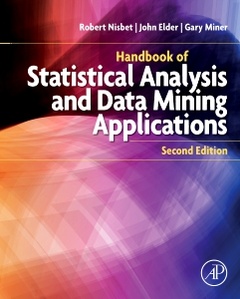Handbook of Statistical Analysis and Data Mining Applications (2nd Ed.)
Auteurs : Nisbet Robert, Miner Gary, Yale Ken

Handbook of Statistical Analysis and Data Mining Applications, Second Edition, is a comprehensive professional reference book that guides business analysts, scientists, engineers and researchers, both academic and industrial, through all stages of data analysis, model building and implementation. The handbook helps users discern technical and business problems, understand the strengths and weaknesses of modern data mining algorithms and employ the right statistical methods for practical application.
This book is an ideal reference for users who want to address massive and complex datasets with novel statistical approaches and be able to objectively evaluate analyses and solutions. It has clear, intuitive explanations of the principles and tools for solving problems using modern analytic techniques and discusses their application to real problems in ways accessible and beneficial to practitioners across several areas?from science and engineering, to medicine, academia and commerce.
Part 1: History Of Phases Of Data Analysis, Basic Theory, And The Data Mining Process 1. The Background for Data Mining Practice 2. Theoretical Considerations for Data Mining 3. The Data Mining and Predictive Analytic Process 4. Data Understanding and Preparation 5. Feature Selection 6. Accessory Tools for Doing Data Mining
Part 2: The Algorithms And Methods In Data Mining And Predictive Analytics And Some Domain Areas 7. Basic Algorithms for Data Mining: A Brief Overview 8. Advanced Algorithms for Data Mining 9. Classification 10. Numerical Prediction 11. Model Evaluation and Enhancement 12. Predictive Analytics for Population Health and Care 13. Big Data in Education: New Efficiencies for Recruitment, Learning, and Retention of Students and Donors 14. Customer Response Modeling 15. Fraud Detection
Part 3: Tutorials And Case Studies Tutorial A Example of Data Mining Recipes Using Windows 10 and Statistica 13 Tutorial B Using the Statistica Data Mining Workspace Method for Analysis of Hurricane Data (Hurrdata.sta) Tutorial C Case Study—Using SPSS Modeler and STATISTICA to Predict Student Success at High-Stakes Nursing Examinations (NCLEX) Tutorial D Constructing a Histogram in KNIME Using MidWest Company Personality Data Tutorial E Feature Selection in KNIME Tutorial F Medical/Business Tutorial Tutorial G A KNIME Exercise, Using Alzheimer’s Training Data of Tutorial F Tutorial H Data Prep 1-1: Merging Data Sources Tutorial I Data Prep 1–2: Data Description Tutorial J Data Prep 2-1: Data Cleaning and Recoding Tutorial K Data Prep 2-2: Dummy Coding Category Variables Tutorial L Data Prep 2-3: Outlier Handling Tutorial M Data Prep 3-1: Filling Missing Values With Constants Tutorial N Data Prep 3-2: Filling Missing Values With Formulas Tutorial O Data Prep 3-3: Filling Missing Values With a Model Tutorial P City of Chicago Crime Map: A Case Study Predicting Certain Kinds of Crime Using Statistica Data Miner and Text Miner Tutorial Q Using Customer Churn Data to Develop and Select a Best Predictive Model for Client Defection Using STATISTICA Data Miner 13 64-bit for Windows 10 Tutorial R Example With C&RT to Predict and Display Possible Structural Relationships Tutorial S Clinical Psychology: Making Decisions About Best Therapy for a Client
Part 4: Model Ensembles, Model Complexity; Using the Right Model for the Right Use, Significance, Ethics, and the Future, and Advanced Processes 16. The Apparent Paradox of Complexity in Ensemble Modeling 17. The "Right Model" for the "Right Purpose": When Less Is Good Enough 18. A Data Preparation Cookbook 19. Deep Learning 20. Significance versus Luck in the Age of Mining: The Issues of P-Value "Significance" and "Ways to Test Significance of Our Predictive Analytic Models" 21. Ethics and Data Analytics 22. IBM Watson
Dr. Gary Miner PhD received a B.S. from Hamline University, St. Paul, MN, with biology, chemistry, and education majors; an M.S. in zoology and population genetics from the University of Wyoming; and a Ph.D. in biochemical genetics from the University of Kansas as the recipient of a NASA pre-doctoral fellowship. He pursued additional National Institutes of Health postdoctoral studies at the U of Minnesota and U of Iowa eventually becoming immersed in the study of affective disorders and Alzheimer's disease. In 1985, he and his wife, Dr. Linda Winters-Miner, founded the Familial Alzheimer's Disease Research Foundation, which became a leading force in organizing both local and international scientific meetings, bringing together all the leaders in the field of genetics of Alzheimer's from several countries, resulting in the first major book on the genetics of Alzheimer’s disease. In the mid-1990s, Dr. Miner turned his data analysis interests to the business world, joining the team at StatSoft and deciding to specialize in data mining. He started developing what eventually became the Handbook of Statistical Analysis and Data Mining Applications (co-authored with Drs. Robert A. Nisbet and John Elder), which received the 2009 American Publishers Award for Professional and Scholarly Excellence (PROSE). The
- Includes input by practitioners for practitioners
- Includes tutorials in numerous fields of study that provide step-by-step instruction on how to use supplied tools to build models
- Contains practical advice from successful real-world implementations
- Brings together, in a single resource, all the information a beginner needs to understand the tools and issues in data mining to build successful data mining solutions
- Features clear, intuitive explanations of novel analytical tools and techniques, and their practical applications
Date de parution : 11-2017
Ouvrage de 822 p.
19x23.4 cm
Disponible chez l'éditeur (délai d'approvisionnement : 14 jours).
Prix indicatif 98,24 €
Ajouter au panierThèmes de Handbook of Statistical Analysis and Data Mining... :
Mots-clés :
business data; statistical analysis; CRISP-DM; SEMMA; text mining; Clementine interface



